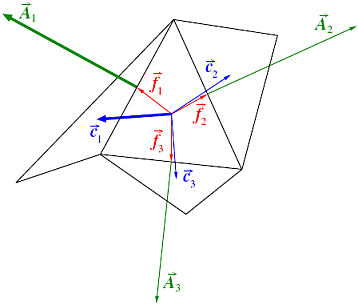The orthogonal quality for cells is determined using three sets of vectors. For each face, the face normal vector (A i), the vector from the cell centroid to the centroid of the adjacent cell (c i), and the vector from the cell centroid to the centroid of the face (f i) are found. See Figure 424: Vectors Used to Compute Orthogonal Quality for a Cell.
For each face, the cosines of the angle between A i and c i and between A i and f i are calculated. The smallest calculated cosine value is the orthogonality of the cell. Finally, Orthogonal Quality depends on cell type:
For tetrahedral, prism, and pyramid cells, the Orthogonal Quality is the minimum of the orthogonality and (1 - cell skewness).
For hexahedral cells, the Orthogonal Quality is the same as the orthogonality.
The minimum value obtained from calculating these quantities for all the faces is defined as the orthogonal quality for the cell. The worst cells will have an orthogonal quality close to 0 while the best cells will have an orthogonal quality close to 1.
Note: Orthogonal quality for a cell is equivalent to Inverse Orthogonal Quality in Ansys Fluent Meshing except that the scale is reversed:
Inverse Orthogonal Quality = 1 – Orthogonal Quality
Orthogonal quality values may not correspond exactly with the inverse orthogonal quality values from Fluent Meshing due to minor tolerance differences in how the data is handled internally.
For 2D surface mesh, a similar calculation is performed using only the edge normal vector (A i) and the vector from the face centroid to the centroid of each edge (e i). See Figure 425: Vectors used to Compute Orthogonal Quality for a Face.




